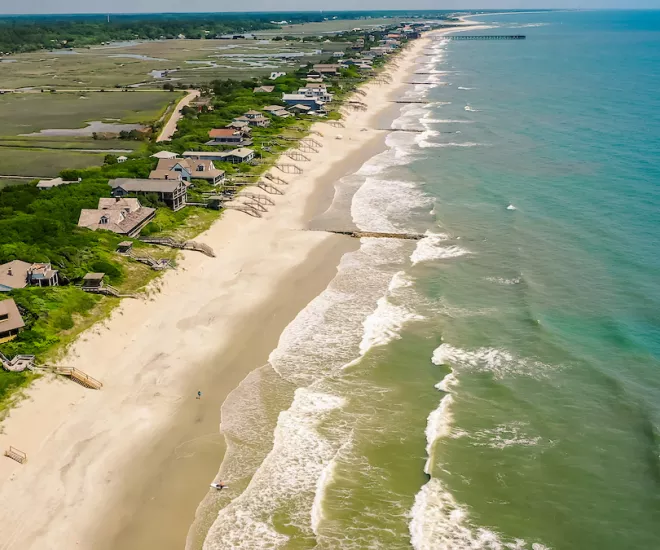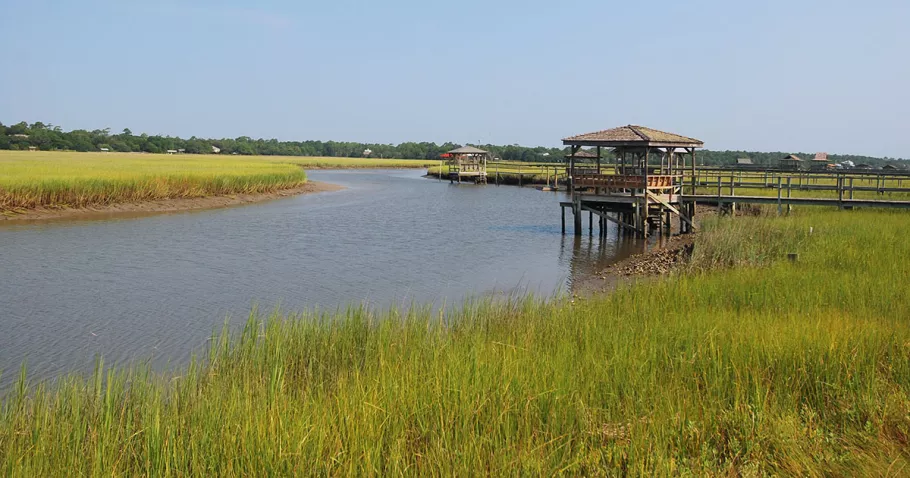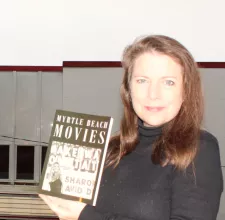History of McKenzie Beach Near Pawleys Island

If you are driving south of Myrtle Beach and you’ve passed Brookgreen Gardens in Murrells Inlet on your right but haven’t made it to the historic Hammock Shops in Pawleys Island on your left, you may notice an odd, but intriguingly beautiful, structure on your left where Ocean Highway (Hwy. 17) is met by Old Beach Road.

It is the ruins of a mid-century modern hotel that has been draped by nature with vines and other vegetation creating an alluring subject for photographers and other artists who are drawn to such finds. What’s odd about it is that the tree-shaded lot that it is on is fairly kept up with an attractive fence that serves as a barrier between the former accommodations and the highway.
There is no sign or marker indicating what it is, but if you ask around, someone may tell you that was McKenzie Beach…but what you saw was a roadside motel. Why the name? Here’s the incredible story.
It was 1934. Myrtle Beach had become a resort three decades before but, because of segregation, African Americans couldn’t go there. That’s when a single Black woman, despite the Great Depression and the myriad of hurdles in the business world that hindered both women and African Americans, got the idea to create a resort where African Americans could go. She would call it The Magnolia Beach Club. She was Lillian Golden Pyatt.
The timing was good. The Lafayette Bridge in Georgetown was just being completed. And with additional roads being built and the country’s infrastructure improvements stemming from FDR’s New Deal programs coming to fruition, Americans were on the move for work and play.
Among them were African Americans who from the 1930s through the 1960s would use the Green Book as their guide in order to, as the book’s tagline described, “Vacation Without Aggravation.” Victor Green, a postal worker from New York, would compile the book every year with the stated hope that there would come a time that it did not need to be published. The annual compilation would list the accommodations, restaurants, entertainment venues and service providers who would welcome Black customers throughout the country. In some locations, the book could be life-saving. It would identify what were known as sundown towns where African Americans were not allowed after sunset and could be in danger if they were.
The number of oceanfront resorts between New York and Miami that catered to a Black clientele were virtually nonexistent. That void was what drove Lillian to make her beach club a reality regardless of how insurmountable the prospect seemed.
Her journey began when she inherited a tract of oceanfront property from a family member, James Smalls. However, she almost lost it before she could claim it because it was about to be auctioned off by the county due to unpaid property taxes. Using her savings to cover the debt, she became the new owner and immediately realized the land’s potential. And she realized its significant shortcoming. There was no direct access from the newly paved Highway 17 to what would be her resort.
She didn’t know who owned the property in between, but soon found out that it too had been recently inherited by an African American woman and her sisters. That heir, Elizabeth “Miss Liz” McKenzie and her husband, Frank, bought out her other siblings and became business partners of Lillian Pyatt, along with Dr. Ulysses Teel who invested additional capital. The McKenzies agreed to live on the property and run the resort while Lillian returned to New York to earn money up there to funnel into their joint-partnership down here.
Construction, bankrolled by Lillian, began in 1936. In the next few years her dream took shape. They built a causeway from the McKenzie property over to the Pyatt land which was sometimes known as Birney Beach. Once they had access, they created the club which consisted of a 24-unit hotel, a white brick dining room trimmed in pink, a pavilion, and fifteen cabins that were used mostly for transient accommodations, but some guests stayed in theirs for the entire summer.
When visitors arrived, they would access the resort by what is now known as Old Beach Road that is still on Highway 17. The road terminated partway at a parking lot that could accommodate the individual cars and tour buses. From there they paid ten or fifteen cents at a booth to cross a pedestrian bridge, about ten feet wide, that was taken to complete the trek to the beach and amenities that sat on the six-acre oceanfront tract. Its natural beauty was enhanced by the 18 acres of marsh that was situated between the Pyatt and McKenzie properties. As an added convenience, a bait and tackle shop was located at the end of the bridge for the fishing enthusiasts among them.
The most striking feature of the resort was a large pavilion restaurant with a performance stage and dance floor. That allowed Lillian to book some of the biggest names in 20th Century music like Ray Charles, Lena Horn and Ella Fitzgerald, to play there because her club was on the Chitlin’ Circuit. That was a string of venues throughout the country where Black musicians could perform when segregation prevented them from appearing at larger, more popular venues. She would also take advantage of the really big named performers of the time, like Duke Ellington, Count Basie and Billie Holiday, who would be booked at Myrtle Beach’s opulent Ocean Forest Hotel and invite them to her club as well. She would offer them free accommodations in exchange for their music.
Tragically, all of this came to a dramatic end on October 15th, 1954, when Hurricane Hazel came in as a Category 4 storm on a high tide under a full moon. The bridge to the club was completely washed away as were all 15 of the guest cabins. What structures were left were decimated. The damage was so severe that the federal government wouldn’t allow the bridge to be rebuilt for fear of the same thing happening in a subsequent storm.
Without a bridge and the exorbitant costs to repair what they did have left; it wasn’t feasible to rebuild. Lillian and Frank dissolved their partnership and The Magnolia Beach Club was no more. The beach front tract that Lillian had inherited was eventually sold and is now the southern tip of Litchfield Beach. If you look at a satellite map of the area, there are no structures on that end where the club once flourished and Hazel took her toll.
In the following years, friends helped the McKenzies rebuild a new, family-friendly resort on the four-acre mainland tract which they continued to call McKenzie Beach. They no longer had access to the shore but enjoyed a beautiful view of the marsh that separated their property from it. That’s when the 12-unit motel that is still seen today came to be. The resort also had a restaurant and tavern along with a bait and tackle shop and several privately owned new homes.
Unfortunately, the financial success of what they once had could not be replicated and, in 1963, the McKenzies were faced with bankruptcy. Just because they were not going to be able to keep McKenzie Beach open didn’t mean that it wasn’t needed as segregation was still prevalent. So two civil rights advocates, Walter M. Manigault and Modjeska M. Simkins, purchased the resort and retained the McKenzies to run it until its initial purpose was no longer needed.
The Manigaults had kept a summer residence there throughout the 1950s and had a wealth of happy memories of the place. Now the subsequent generations of that family remain the caretakers of that property. No plans have been announced as yet about what its future holds.
The previous owners, Frank McKenzie and Lillian Pyatt, both passed away in 1978. Now with the efforts of the Manigault Family there is hope that the resort that brought happiness and inclusion to so many will not be forgotten after all.
